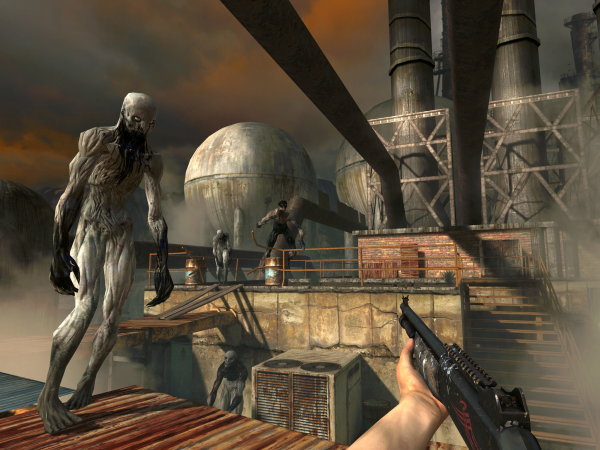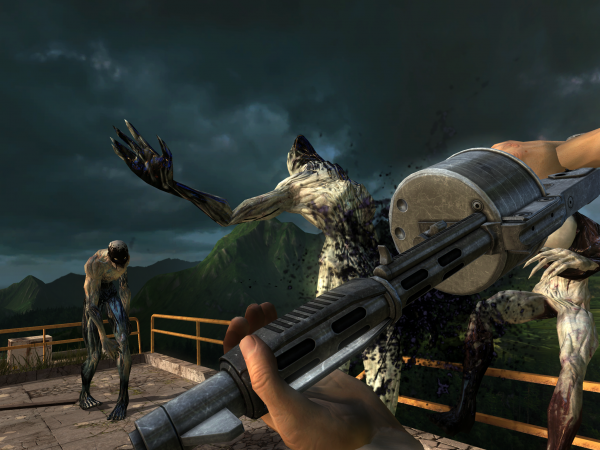The Drowning Launches Worldwide; Why Developer Ben Cousins Thinks His Studio Has Made the Best Mobile FPS Yet
Why does Ben Cousins of Scattered Entertainment think that his new mobile FPS is the one to revolutionize the genre?

DeNA and Scattered Entertainment’s ambitious mobile first-person shooter spearheaded by former Battlefield series producer Ben Cousins, The Drowning, has finally launched worldwide. After the first hands-on sessions at GDC 2013 the game has been in an international soft launch, but the final, complete version of the game is now available to everyone. I spoke with Ben Cousins about what he thinks this initial "complete" version of The Drowning succeeds at, and how the game has evolved over the past few months.
Cousins says that he’s quite proud of the way that Scattered Entertainment experimented with new control schemes. “…We were unsatisfied with the FPSes on mobile devices, and I think from our research, I think a lot of the potential audience who are really interested in the genre have a phone or a tablet, and they’re not satisfied with what they’ve got out there.” There’s two things that he thinks they have that others don’t; “The first thing that we’ve got which the competitors haven’t is a control system which is designed for touchscreens that you can play with just one hand, with just two fingers in fact on one hand, and one that really fluidly fits in with the way that we hold these devices and the usage patterns of these devices. So we’re really proud that we’ve created a control system which kind of unlocks the potential of this genre on the platform.”
 "The second thing we’ve done is we’ve really respected the usage patterns of these devices as well. And we understand that people generally don’t sit down and create time for a four or five hour session of playing a game on a smart device. So we’ve deliberately created a game structure that means within two minutes you can make progress in the game and you can shut down the device, and you can bring it up for a two-minute session at any time, and you’re guaranteed to make progress.
"The second thing we’ve done is we’ve really respected the usage patterns of these devices as well. And we understand that people generally don’t sit down and create time for a four or five hour session of playing a game on a smart device. So we’ve deliberately created a game structure that means within two minutes you can make progress in the game and you can shut down the device, and you can bring it up for a two-minute session at any time, and you’re guaranteed to make progress.
“So we’ve divided the game into these discrete chunks. The gameplay feels very much like an FPS, you’re killing enemies, and it’s high action, and you’re in this 3D world, but the system we’ve created enables you to jump in and jump out in a way which a more console-style mobile-FPS doesn’t really let you do, you’ve got to wait for a save point or for a cutscene to finish or something like that.”
Interestingly, though, there’s a virtual control scheme in there as well, and Cousins justifies it by saying “If you remember back on Halo 1, you could actually opt to play that with the GoldenEye control scheme. Now the GoldenEye control scheme is very different from the Halo/Call of Duty control system. So in the same way that in that transition that Halo had to acknowledge the small numbers of players who were used to the GoldenEye style of controls, we’ve kind of done the same thing, we believe that the touch system we’ve created is the future of controlling FPSes on smart devices, but we also acknowledge that there is kind of a legacy on this platform and a certain number of people want to play with a traditional virtual stick style system.” He does believe that it’s a suboptimal way to play – and that most will switch to the ‘new’ control scheme, just as how console gamers have adapted to the scheme Halo introduced.
 The international soft launch helped out in several ways. Cousins states, “So we actually went out with probably, an incomplete game, just because we got to the point where just playing it ourselves and trying got work out whether a feature was working or not wasn’t really helping, and we wanted to get on to the live audience,so that’s kind of what we did, and we’ve been adding a whole bunch of stuff that was in that backlog anyway.” The tutorial got trimmed down as part of the changes, and a stars system was added, which Cousins claims helped player satisfaction: “the game’s about going into these environments, playing for two minutes, getting a score, and then getting parts. Kind of exchanging that score for parts which you find the environment that you can then use to craft more weapons. And we never really had a clear way of showing the player whether they had a good score or a bad score. So players we were thinking were probably going in there and what was a reasonable score and actually they weren’t getting enough score to get that particular part that they need from the environment.”
The international soft launch helped out in several ways. Cousins states, “So we actually went out with probably, an incomplete game, just because we got to the point where just playing it ourselves and trying got work out whether a feature was working or not wasn’t really helping, and we wanted to get on to the live audience,so that’s kind of what we did, and we’ve been adding a whole bunch of stuff that was in that backlog anyway.” The tutorial got trimmed down as part of the changes, and a stars system was added, which Cousins claims helped player satisfaction: “the game’s about going into these environments, playing for two minutes, getting a score, and then getting parts. Kind of exchanging that score for parts which you find the environment that you can then use to craft more weapons. And we never really had a clear way of showing the player whether they had a good score or a bad score. So players we were thinking were probably going in there and what was a reasonable score and actually they weren’t getting enough score to get that particular part that they need from the environment.”
 “So we have a very direct feedback at the end of the round of whether you got a bad score or whether you got an awesome score, and this really helps the game loop because you do two things: you know you either just failed to get a score you wanted to get that part, and you want to play another round, or you’ve just succeeded in getting the score and it’s a fantastic kind of reinforcement moment in the game loop where you’re really excited because you just got that score that you needed to proceed.”
“So we have a very direct feedback at the end of the round of whether you got a bad score or whether you got an awesome score, and this really helps the game loop because you do two things: you know you either just failed to get a score you wanted to get that part, and you want to play another round, or you’ve just succeeded in getting the score and it’s a fantastic kind of reinforcement moment in the game loop where you’re really excited because you just got that score that you needed to proceed.”
These little things may just make The Drowning a better experience, which players can now judge for themselves, as it is now available worldwide on the App Store.

